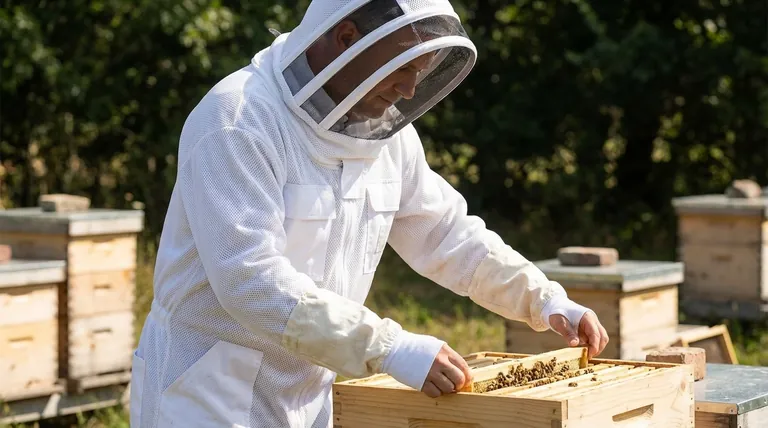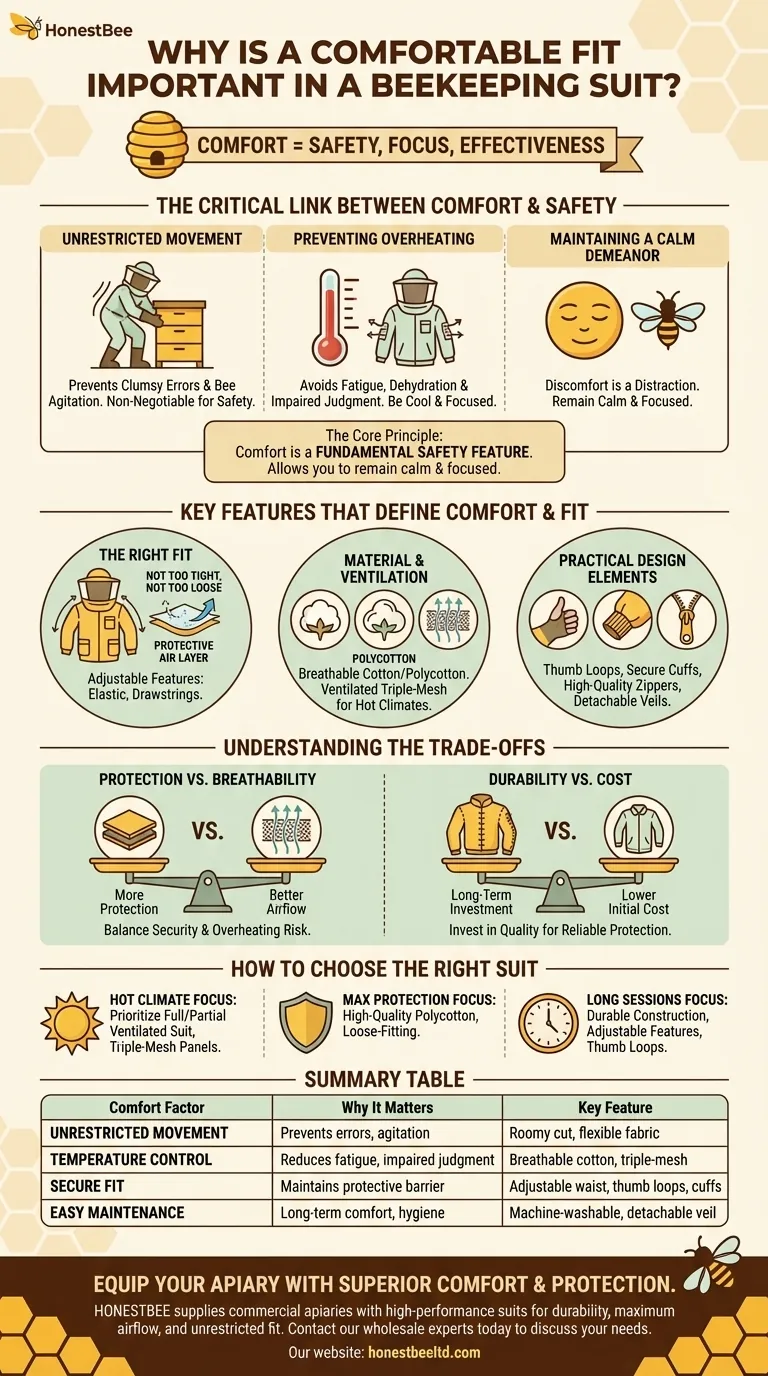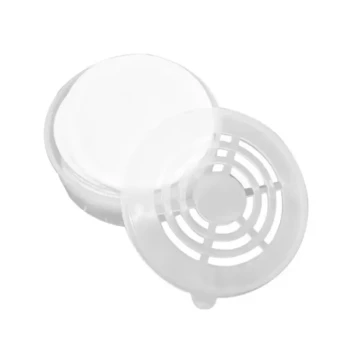A comfortable fit is critical for a beekeeping suit because it directly impacts your safety, focus, and effectiveness. An uncomfortable suit restricts movement, causes overheating, and creates distractions—all of which increase the risk of mistakes, stings, and stress for both you and your bees.
The core principle to understand is that comfort is not a luxury; it is a fundamental safety feature. A comfortable suit allows you to remain calm and focused, which is your most important tool when working with a hive.

The Critical Link Between Comfort and Safety
An ill-fitting or uncomfortable suit is more than an annoyance; it's a liability. Your ability to work safely depends on your ability to move freely and think clearly.
Unrestricted Movement is Non-Negotiable
A suit that is too tight binds at the shoulders, knees, and elbows. This restriction makes essential tasks like lifting heavy hive boxes or performing delicate inspections clumsy and difficult.
Free movement is crucial for reacting smoothly and deliberately around the hive, preventing sudden, jerky motions that can startle and agitate the bees.
Preventing Overheating and Fatigue
Beekeeping is often done on warm, sunny days. A suit made from non-breathable material or one that lacks proper ventilation can quickly turn into a personal sauna.
Overheating leads to fatigue, dehydration, and impaired judgment. Features like triple-mesh construction and high-quality air mesh are designed specifically to regulate your body temperature and keep you focused.
Maintaining a Calm Demeanor
Discomfort is a distraction. When you are constantly adjusting a sleeve, feeling constricted, or overheating, your attention is not fully on the bees.
This distraction can cause you to miss important hive cues or make clumsy errors. A calm, focused beekeeper is a safe and effective beekeeper.
Key Features That Define Comfort and Fit
When evaluating a suit, specific design elements contribute directly to its comfort and, by extension, its safety and usability.
The Right Fit: Not Too Tight, Not Too Loose
Your suit should allow a complete range of motion without being excessively baggy. A slightly loose fit is ideal, as it creates a layer of air between the fabric and your skin, making it harder for a bee's stinger to reach you.
Look for suits with adjustable features like elasticized waistbands or drawstrings to customize the fit to your body.
Material and Ventilation
The suit's material is a primary factor in comfort. Cotton is breathable and soft, while polycotton blends offer a balance of durability and comfort.
For beekeepers in warmer regions, a ventilated suit with panels of triple-layer mesh on the torso, back, and arms is the superior choice for airflow.
Practical Design Elements
Small details make a significant difference. Thumb loops and elastic cuffs keep your sleeves securely in place when you reach and lift, preventing them from riding up and exposing your wrists.
High-quality zippers that are easy to use with gloves on, and detachable veils for easy cleaning, also contribute to the overall experience.
Understanding the Trade-offs
Choosing the perfect suit involves balancing competing priorities. Understanding these trade-offs will help you make an informed decision.
Protection vs. Breathability
Thicker, non-ventilated materials may offer a greater sense of psychological security and physical protection from stings.
However, this often comes at the cost of breathability, increasing the risk of overheating. Ventilated suits provide excellent airflow but may feel less substantial to a novice.
Durability vs. Cost
Investing in a high-quality suit with durable stitching and robust materials will ensure it lasts for many seasons and provides reliable protection.
While the initial cost may be higher, a well-made suit is a better long-term investment than a cheaper alternative that may fail at a critical moment.
Ease of Maintenance
A suit covered in honey, wax, and propolis becomes stiff and uncomfortable. Look for suits that are machine washable or have detachable veils for easier cleaning.
Regular maintenance not only extends the suit's life but also prevents the potential spread of bee diseases between your hives.
How to Choose the Right Suit for Your Needs
Your choice should be guided by your climate, beekeeping style, and personal comfort threshold.
- If your primary focus is working in a hot climate: Prioritize a fully or partially ventilated suit with triple-mesh panels to maximize airflow and prevent overheating.
- If your primary focus is maximum protection and peace of mind: A high-quality polycotton suit offers excellent durability, but ensure it is loose-fitting to maintain mobility and a protective air gap.
- If your primary focus is frequent, long work sessions: Invest in a durable, well-constructed suit with adjustable features and thumb loops for superior long-term comfort and reliability.
Ultimately, the right beekeeping suit is one you feel secure and comfortable in, transforming hive inspections from a daunting chore into a focused and enjoyable experience.
Summary Table:
| Comfort Factor | Why It Matters | Key Feature to Look For |
|---|---|---|
| Unrestricted Movement | Prevents clumsy errors and bee agitation | Roomy cut, flexible fabric |
| Temperature Control | Reduces fatigue and impaired judgment | Breathable cotton, triple-mesh ventilation |
| Secure Fit | Maintains a protective barrier against stings | Adjustable waistbands, thumb loops, elastic cuffs |
| Easy Maintenance | Ensures long-term comfort and hygiene | Machine-washable, detachable veil |
Equip your apiary with superior comfort and protection. The right beekeeping suit is an investment in safety and productivity. HONESTBEE supplies commercial apiaries and distributors with high-performance suits designed for durability, maximum airflow, and an unrestricted fit. Let us help you select the ideal gear for your climate and workflow. Contact our wholesale experts today to discuss your needs.
Visual Guide

Related Products
- Wholesales Dadant Size Wooden Bee Hives for Beekeeping
- Long Langstroth Style Horizontal Top Bar Hive for Wholesale
- Professional Insulated Winter Hive Wrap for Beekeeping
- Automatic Honey Flow Beehive 4 Frame Mini Hive for Beekeeping
- Professional Insulated Plastic Bee Hives
People Also Ask
- What are the essential pieces of equipment for most beekeepers? Get Started with the Right Gear
- What types of products are available for beekeeping needs? Essential Equipment for Apiaries & Distributors
- What is beekeeping equipment? Essential Tools for Commercial Apiaries & Distributors
- What are the advantages of wooden bee hives? Superior Bee Health & Beekeeper Flexibility
- What should beginners consider when purchasing beekeeping equipment? A Guide to Essential Starter Gear



















